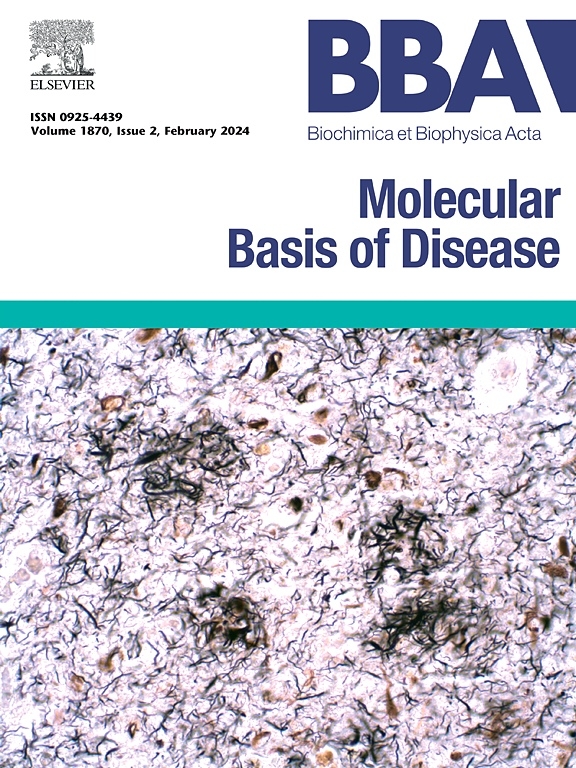The oxidants hypochlorite and hydrogen peroxide induce distinct patterns of acute lung injury
IF 4.2
2区 生物学
Q2 BIOCHEMISTRY & MOLECULAR BIOLOGY
Biochimica et biophysica acta. Molecular basis of disease
Pub Date : 2004-11-05
DOI:10.1016/j.bbadis.2004.07.003
引用次数: 0
Abstract
Oxidative stress due to activated neutrophils, macrophages and endothelial cells plays a crucial role in acute lung injury. This study compares the effects of the nonradical oxidants hypochlorite (HOCl) and hydrogen peroxide (H2O2) on pulmonary artery pressure [PAP (torr)], capillary filtration coefficient (Kf,c), tissue lipid peroxidation (LPO) and reduced glutathione (GSH) depletion. HOCl, H2O2 (1000 nmol min−1) or buffer (control) is infused into isolated rabbit lungs. PAP, Kf,c and lung weight were measured. Experiments were terminated after 105 min or when fluid retention exceeded 50 g. Lung tissue was analyzed for LPO products and GSH. The oxidants induced comparable maximum effects. However, the patterns of lung injury were distinct: H2O2 infusion evoked an early biphasic pressure response (ΔPAPmax 2.8±0.22/4.2±0.37 after 5.7±1.4/39±4.0 min) and a sixfold increase in Kf,c after 90 min. HOCl application caused a late pressure response (ΔPAPmax 7.6±1.7 after 50.6±3.7 min) and a sevenfold increase in Kf,c after 60 min. H2O2-induced effects were attenuated by desferal. This may suggest an involvement of transition metal catalysed hydroxyl radical formation. Different oxidants induced distinct patterns of changes in PAP and Kf,c, which are accompanied by a comparable accumulation of LPO products and by a distinct degree of GSH depletion.
氧化剂次氯酸盐和过氧化氢诱导急性肺损伤的不同模式
由活化的中性粒细胞、巨噬细胞和内皮细胞引起的氧化应激在急性肺损伤中起重要作用。本研究比较了非自由基氧化剂次氯酸盐(HOCl)和过氧化氢(H2O2)对肺动脉压[PAP (torr)]、毛细血管过滤系数(Kf,c)、组织脂质过氧化(LPO)和还原性谷胱甘肽(GSH)消耗的影响。将HOCl、H2O2 (1000 nmol min−1)或缓冲液(对照)注入离体兔肺。测定PAP、Kf、c和肺质量。实验在105min后或当液体潴留超过50g时终止。分析肺组织中LPO产物和谷胱甘肽。氧化剂引起了类似的最大效应。然而,肺损伤的模式是不同的:H2O2输注引起早期双相压力反应(5.7±1.4/39±4.0 min后ΔPAPmax 2.8±0.22/4.2±0.37),90 min后Kf,c增加6倍。HOCl应用引起晚期压力反应(ΔPAPmax 7.6±1.7后50.6±3.7 min), 60 min后Kf,c增加7倍。这可能暗示了过渡金属催化羟基自由基形成的参与。不同的氧化剂诱导不同模式的PAP和Kf,c的变化,这伴随着相当的LPO产物积累和不同程度的谷胱甘肽消耗。
本文章由计算机程序翻译,如有差异,请以英文原文为准。
求助全文
约1分钟内获得全文
求助全文
来源期刊
CiteScore
12.30
自引率
0.00%
发文量
218
审稿时长
32 days
期刊介绍:
BBA Molecular Basis of Disease addresses the biochemistry and molecular genetics of disease processes and models of human disease. This journal covers aspects of aging, cancer, metabolic-, neurological-, and immunological-based disease. Manuscripts focused on using animal models to elucidate biochemical and mechanistic insight in each of these conditions, are particularly encouraged. Manuscripts should emphasize the underlying mechanisms of disease pathways and provide novel contributions to the understanding and/or treatment of these disorders. Highly descriptive and method development submissions may be declined without full review. The submission of uninvited reviews to BBA - Molecular Basis of Disease is strongly discouraged, and any such uninvited review should be accompanied by a coverletter outlining the compelling reasons why the review should be considered.

 求助内容:
求助内容: 应助结果提醒方式:
应助结果提醒方式:


